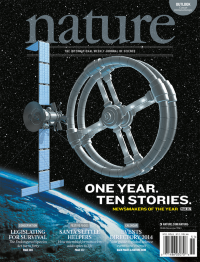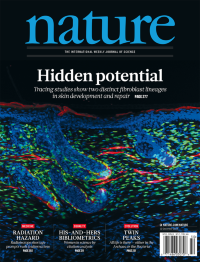Volume 504
-
No. 7480 19 December 2013
In Nature Ten� we take stock of the highs, lows and newsmakers of the past twelve months as part of our year-end round up of 2013. Image: Bryan Christie Design/PHOTODISC.
Nature Outlook
-
No. 7479 12 December 2013
Grafted dermal fibroblasts (labelled green) shown supporting new hair follicle formation. Fibroblasts are unremarkable looking cells found in most tissues in the body, where they are mainly concerned with making the collagen that supports other cell types. The cells all look alike yet are functionally diverse, prompting the question, is there just one cell type responding differently to different stimuli, or do individual cells specialize? A transplantation and lineage tracing study in mice now shows that skin connective tissue arises from two distinct fibroblast lineages that also contribute differentially to skin development and repair after injury. One cell type forms the lower dermis and the other the upper dermis. The latter lineage is required for hair follicle production and is shown on the cover in green surrounding new hair follicles and contributing to the smooth muscles (red) that contract to make hair follicles stand on end. In wounded adult skin, the initial wave of dermal repair is mediated by the lower� lineage, which may explain the absence of hair follicles in newly closed wounds. The authors develop a comprehensive lineage tree for all fibroblast-derived cell types in mouse dermis, including smooth muscle cells and adipocytes. COVER: Ryan Driskell, Kings College London
-
No. 7478 5 December 2013
Current theories on the formation of our Moon have taken something of a battering from recent observations and the latest computer simulations. In this issue of Nature, Robin Canup in a Comment, and contributions from Tim Elliott and Sarah Stewart in a News & Views Forum, present their views on how theoretical treatments can respond to the challenge.
Insight



